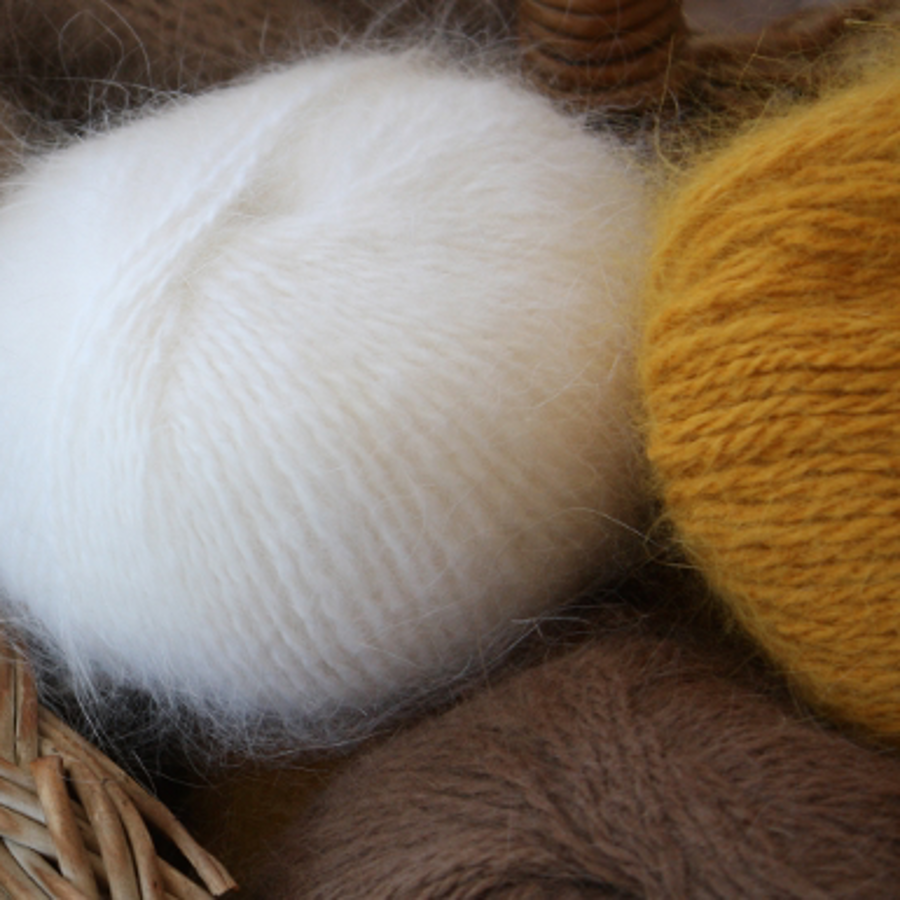
Can you get DNA from an angora sweater to prove it is real?
July 31, 2008

- Related Topics:
- Quirky questions,
- Genetic testing
A curious adult from the United Kingdom asks:
"Can you get wool (hair) from a supposed angora sweater and get DNA from it to prove it is or isn’t angora?"
It is certainly possible to tell if a sweater is angora (or at least came from rabbit wool) by checking its DNA.
But an easier method is just to look at the wool strands under the microscope. If you can find an expert in animal hairs, he or she can tell if the sweater is rabbit, sheep, or any other kind of wool. I'll go over each method to explain how they work.
First I'll talk about DNA, and then I'll talk about telling hairs apart under the microscope.
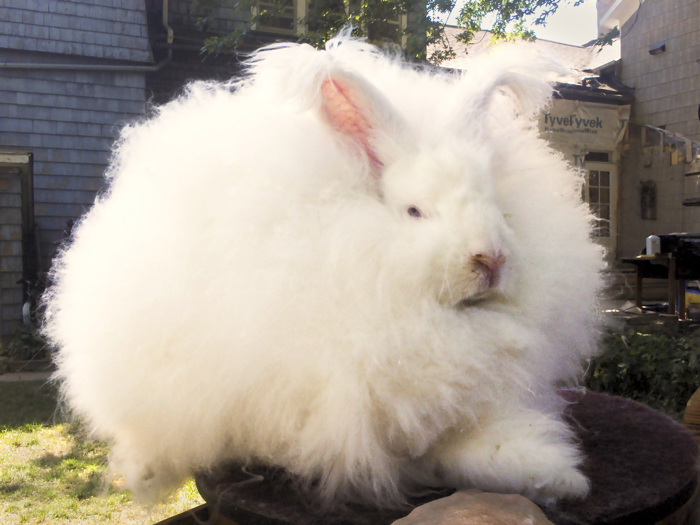
Hair DNA
At first it might seem weird that we can get DNA from hair. The hair from the sweater (and all hair) is made up of dead cells and lots of protein, called keratin. We can get some DNA out of the dead cells that make up the hair, but it's probably not the DNA you were expecting.
We can only get a lot of a kind of DNA called mitochondrial DNA (mtDNA). Every animal has DNA in two places in its cells.
One place, called the nucleus, has the "typical" DNA that you hear about all of the time. This nuclear DNA holds the instructions for making us who we are and is also in charge of what we look like. This is the kind of DNA that makes you a human and a rabbit a rabbit. Everyone has different nuclear DNA, except for identical twins. This DNA is important for positively identifying a person (or a rabbit).
Unfortunately, unless a hair gets pulled out by the root, there will be little or no nuclear DNA. This is because the nuclear DNA gets all chopped up in dead cells. So we probably won't have any luck trying to get a lot of nuclear DNA from our sweater.
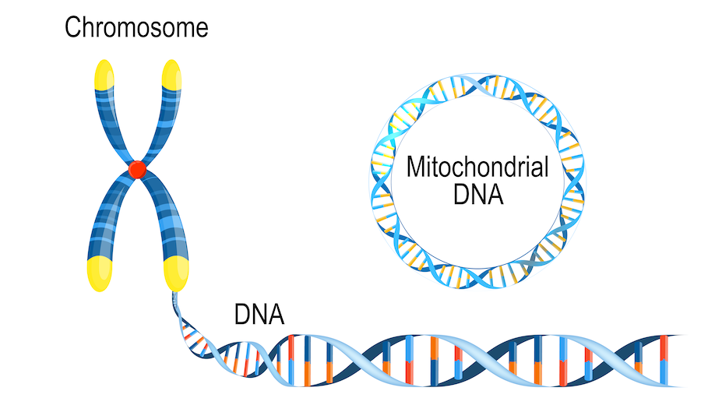
But we'll have better luck with mtDNA. The reason we'll be able to get mtDNA is because there are so many more copies of it in each cell.
Each cell has a single nucleus. This makes sense because the nucleus is there to store and protect the DNA. But this also means there are only two copies of each chromosome per cell (one from mom and one from dad). Mitochondria are a different matter, though. Depending on the cell type, there could be thousands of mitochondria present in each cell!
This makes sense because the mitochondria's job is to make energy for the cell. The more energy a cell needs, the more mitochondria it has. What this also means is that cells will have many more copies of mtDNA than nuclear DNA.
One major difference between mtDNA and nuclear DNA is that many people can have the same mtDNA. This is because we get our mitochondria, and therefore our mtDNA, only from our mother. You share your mtDNA with your siblings, your mom, her mother and her mother and so on.
So you can't use mtDNA to positively identify an individual person or rabbit. But you can use it to identify a species. Many people share the same mtDNA. But all people's mtDNA is different from all chimpanzee mtDNA. Or rabbit mtDNA. And the same is true for rabbit mtDNA and goat or sheep mtDNA. In other words, we can definitely tell if the sweater is made of rabbit wool from its mtDNA.
Comparing DNA
DNA is made up of 4 different chemicals that are usually abbreviated as A, G, C, and T. Every living thing has these 4 letters arranged in a different order. This is called the DNA sequence.
In a perfect world, we'd just compare the whole mtDNA sequence from the sweater to an angora rabbit's mtDNA. But this isn't a perfect world. We are limited by a couple of things.
First off, it is really expensive to look at all of the DNA of something. Even something as "small" as mtDNA. What this means is that we can only really look at bits of the DNA.
Another issue is that there are lots of different kinds of angora rabbits. Each kind will have a slightly different mtDNA sequence. So we can't know for sure if the hair is angora or not.
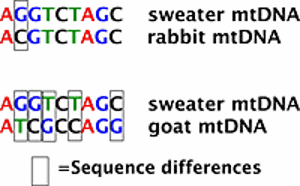
But even with these limitations, we can certainly tell if the sweater came from a rabbit or not. Scientists would compare the DNA from the sweater to known rabbit DNA sequences. If there aren't too many differences, then it is probably an angora sweater!
Now, this is not something just anyone can do. The problem is, I haven't seen any places that will actually test your sweater for you. DNA testing of wool is occasionally done to check product quality, but this isn't very common. Also, processed wool may have less DNA if it was exposed to harsh chemicals during the journey from hairs to wool. This means you'd have a harder time trying to get enough DNA to check whether it's really angora.
Wow, that seems like a lot of work just to see if our sweater is really angora.
Hair Microscopy
There is an easier and cheaper way to see if our sweater is real: just look at the hair! Forensic scientists use this method all the time to help solve crimes.
All hair is made up of several layers. These layers are impossible to see by eye, but when you look at them in a microscope you can see there are many ways you could tell two people (or animals) apart by their hair.
There are three layers in hair: the medulla, cortex, and cuticle. Each can give you information about where the hair came from.
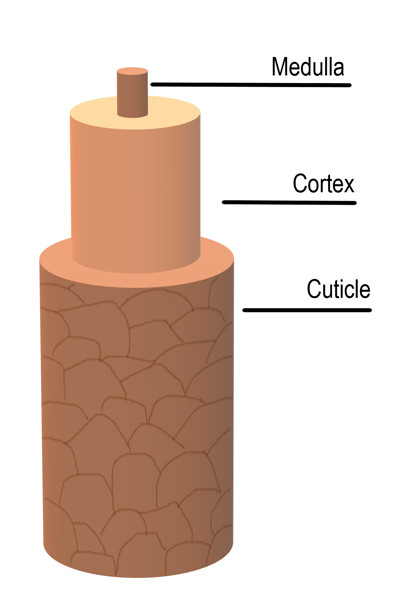
Medulla
The innermost layer is called the medulla. The medulla is made up of a bunch of cells lined up in the center of the hair, but sometimes a hair will have air instead of cells. This happens sometimes in light colored hair.
In humans, the medulla doesn't look very exciting. But hair from animals usually has very clear patterns that are different from animal to animal. This helps us figure out whether a hair is human or animal as well as what kind of animal it's from!
Cortex
The middle layer is called the cortex. The cortex is the layer responsible for the color and strength of your hair.
This layer has specks of pigment that give hair its color, and the position of the specks in this layer also will give us a clue as to whether the hair is animal or human.
Cuticle
Finally, the cuticle is the thin outermost layer that protects the rest of the hair. It actually looks like scales covering the outside of the hair.
You may not believe it, but the shape and size of the scales can look really different. Sometimes it can help us to decide what animal the hair comes from just by seeing what type of scale makes up the cuticle.
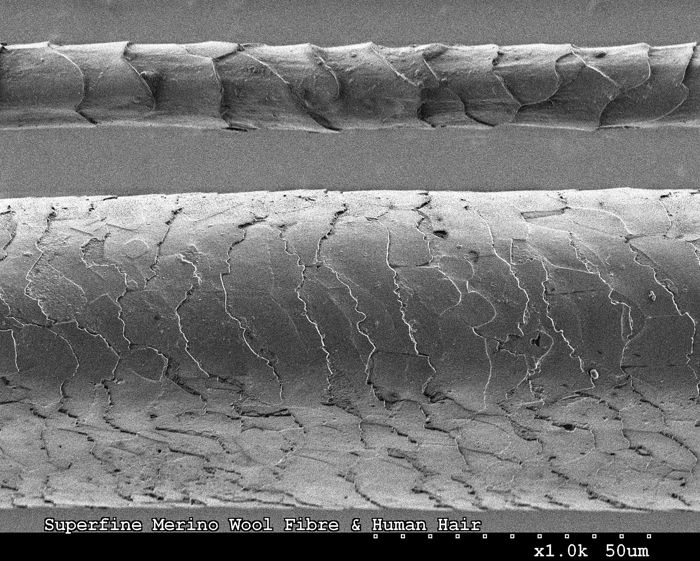
Under a microscope, you can see very small differences that you could never see by eye. This way, you can compare hair from your sweater to real Angora rabbit hairs (or pictures). If your sweater is made of wool from a completely different animal, you will be able to tell just by checking out the hair up close. So the next time you want to check if your angora sweater is real, just take a closer look!

Author: Jamie Conklin
When this answer was published in 2008, Jamie was a Ph.D. candidate in the Department of Genetics, studying control of embryonic stem cells in Julien Sage's laboratory. Jamie wrote this answer while participating in the Stanford at The Tech program.
 Skip Navigation
Skip Navigation
